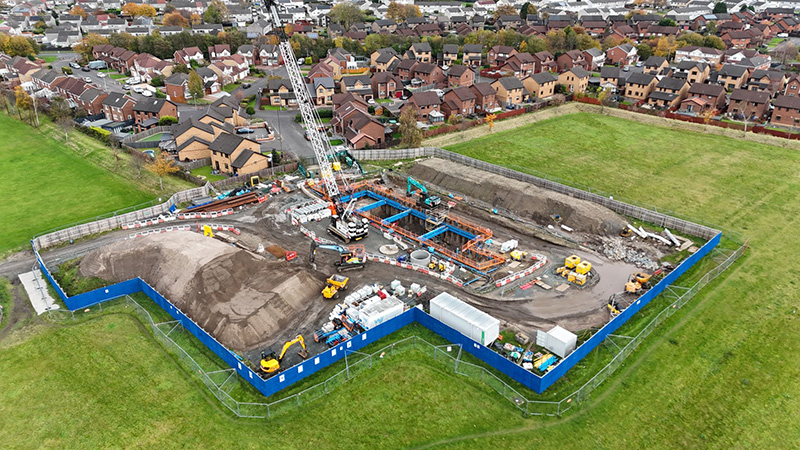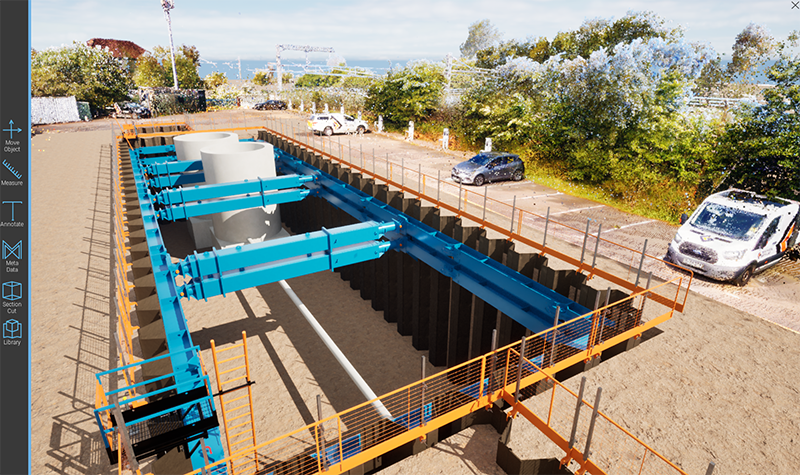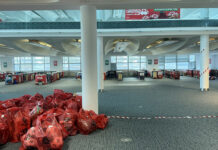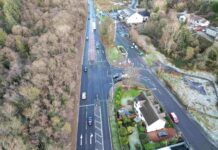
Ryan Smillie (design team leader) and Jamie McLachlan (regional sales manager) from Mabey Hire tell Project Scotland about the use of digital engineering in a project to restore critical infrastructure and repair a collapsed sewer in Glasgow
Q) Can you provide an overview of the project and what Mabey Hire’s role involved?
Jamie: The project at Provost Driver Court in Glasgow focused on restoring critical Scottish Water infrastructure and repairing a collapsed sewer. To deliver the scheme, Scottish Water appointed George Leslie as the principal contractor, who in turn engaged Mabey Hire to design and supply the temporary works excavation support, which included sheet piling and hydraulic framing. In addition, we developed a detailed digital model of the cofferdam, enabling early identification of potential clashes and providing clear insight into how the temporary and permanent works would interact.
Q) What were some of the biggest challenges and how were they overcome?
Jamie: The site presented challenging ground conditions, compounded by a high groundwater table that added complexity to the design. Careful project phasing was essential, with multiple elements introduced to accommodate associated works beyond the main cofferdam. As no client model was available, we created the environment in-house, developing it from 2D drawings and transforming it into a fully detailed 3D space.

Q) What factors do you have to take into consideration when embarking on a project like this?
Ryan: Collaboration with external stakeholders at key stages of the project required an agile and flexible approach. For example, we worked closely with a de-watering specialist to model the impact of groundwater on the excavation. Ongoing engagement throughout was essential to ensure the project progressed safely, efficiently, and to programme.
Continuity of design resource is also critical, not only for building strong relationships and trust, but for maintaining the deep project knowledge required. Our design engineer, Stuart Smillie, was involved from the outset, helping to develop the design brief alongside George Leslie. He continued to lead the design work through to handover, at which point our design team leader, Conner Nixon, provided the delivery team with technical support to ensure successful implementation on site.
Q) Did you utilise any innovative practices or solutions to aid the construction?
Ryan: Digital engineering was central to the success of the project. Led by our digital engineering manager, Andrew Gascoine, the team coordinated digital rehearsals and tested multiple scenarios within a virtual environment. This enabled us to identify and resolve potential issues at an early stage, helping to keep the programme on track and ensuring efficient delivery on site. It also strengthened collaboration and trust with the customer, client, and wider stakeholders. By using Autodesk Revit as standard, we were able to provide additional visual clarity, modelling the permanent works alongside our frames in a 3D space to clearly demonstrate how the two interacted.
Jamie: For a bit of fun, and to showcase our capabilities, we also brought the project to life at the George Leslie 2024 Innovation Day. Using a drone scan of their head office, we dropped our cofferdam model into the car park (no cars were harmed in the process!). This playful demonstration highlighted the scale of the cofferdam within a familiar environment, underscoring the practical benefits and versatility of working in a digital space.

Q) What benefits can digital engineering bring to projects such as this?
Jamie: It enhances accuracy by enabling our modelling software to visualise project phasing and anticipate potential issues. Precise clash detection helps prevent delays, while embedded metadata for all products streamlines the creation of RAMS and lift plans on site, supporting safer and more efficient operations. Additionally, the latest version of our EVE modelling software now incorporates embodied carbon data for every enquiry, fully visible on all quotes, empowering our customers to make more informed and sustainable decisions.
Ryan: Aligned with our ESG strategy, digital engineering enables meaningful engagement in a virtual space, allowing stakeholders across a project to collaborate online and reducing our overall carbon footprint. In a world increasingly shaped by gaming, online platforms, and digital experiences, we are embracing cutting-edge technologies such as Unreal Engine. We believe the intersection of gaming and construction offers an exciting opportunity to inspire and attract the next generation of talented young people into the industry.
Q) Was there anything about the project that surprised you?
Jamie: No, because this project was developed collaboratively with the George Leslie team and other key stakeholders over a two-year period. Continuity of the team, combined with digital engineering modelling, ensured everyone remained fully engaged throughout, effectively eliminating potential issues or surprises.
Q) What has been the reaction/feedback to the completed scheme?
Jamie: The project further strengthened our relationship with George Leslie and reinforced a shared commitment to using digital engineering as a standard approach for developing and delivering civil engineering infrastructure projects across all sectors.
As a Scottish Water framework supplier for trenching and shoring, we have shared the scheme with Scottish Water, who recognise the positive impact of digital engineering on future projects.
Ryan: This approach isn’t limited to one sector. We are actively engaging with key customers and engineering consultancies, all of whom are eager to embrace smart and emerging technologies to drive innovation and efficiency. This is widely seen as the future of construction.











